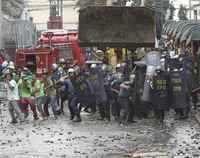Philippines, 2011 Eviction Report: the highest number of documented evictions since 1994
The year 2011 had the highest number of documented cases of eviction since 1994, according to a study of Urban Poor Associates’ (UPA), a housing rights advocate. From January to December 2011, 14, 744 families or 73,780 individuals were evicted in 39 demolition incidents. 92 percent of evictions are considered illegal as they lack requirements called for in the Urban Development and Housing Act. Seven demolitions turned violent.
Families in Corazon De Jesus, San Juan, had experienced eviction several times in the past. People’s resistance had stopped the evictions. On Jan 11 2012, they faced again the city government-led demolition team, using Molotov bombs, stones and bottles. The police managed to break their barricades, using water cannon, bulldozers and teargas. The residents, mostly women, could only run away to save their belongings.
According to some residents from Corazon De Jesus, the land had been awarded to them by former president Corazon Aquino through Proclamation No. 164, which was amended by Proclamation No. 54 issued by former president Gloria Macapagal Arroyo. The San Juan City government ignored these decrees to make way for a new City Hall.
Violent demolitions also occured in Brgy. San Roque, North Triangle, Quezon City and in Bernardino St., Laperal Cmpd., Brgy. Guadalupe Viejo, Makati, thousands of families were removed.
Out of 39 eviction incidents, 28 cases happened in Quezon City. Navotas, Manila and Paranaque were next with two cases each. Some 74 percent of all cases were ordered by local government units.
National Housing Authority (NHA) which owns the North Triangle chose to lease the area for business purposes rather than provide shelter for informal settlers.
Sadly, 2,453 families or 17 percent of the total number of evicted families received nothing from government.
These eviction incidents are considered high compared to those of former President Gloria Macapagal-Arroyo during her first and second years. Also she had signed a number of presidential proclamations making government lands available for socialized housing sites for the poor, while president Aquino has not issued any proclamations. On December 10, 2002, President GMA issued Executive Order No. 152 demanding government agencies secure certificates of compliance before implementing demolitions. This helped lessen the number of evictions for a time, but they still increased towards the end of her term.
Alicia Murphy, Field Director of UPA said, “President Benigno Aquino’s record on evictions, including illegal and violent evictions is, sad to say, not better than that of former Presidents. He must take action as promised in the Covenant of the Urban Poor.”
“We are thankful to the formation of the Technical Working Group under Secretary Jesse Robredo and its efforts to relocate poor families on-site or in-city. There have been many obstacles and delays. TWG is controversial, as are most important new works,” Murphy added.
In parting, Murphy said, “Families living in Estero De San Miguel, Manila, have high hopes that on-site housing will be implemented in their area. The president on December 21 mentioned that groundbreaking would soon be done there. We will hold on to his promises.”

